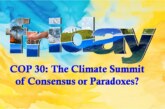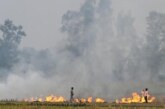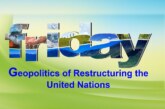Director General | International Centre for Integrated Mountain Development (ICIMOD)

Dr. Pema Gyamtsho is the Director General of the International Centre for Integrated Mountain Development (ICIMOD) an intergovernmental knowledge organization dedicated to mountains and people of the Hindu Kush Himalayan region. Having begun his tenure during the October 2020 Ministerial Mountain Summit, Dr Gyamtsho takes up the globally significant HKH Call to Action work among his leadership priorities for the institution. He had served the Royal Government of Bhutan for over three decades, holds a PhD in Natural Science from the Swiss Federal Institute of Technology in Zurich and a deep passion for the people of the HKH region.
The role of regional cooperation in achieving the SDGs in the Hindu Kush Himalaya
As the United Nations marks its 75 years of existence, we have a moment to reflect on the status of mountain regions on the world stage. In particular, the mountain regions of the Hindu Kush Himalaya, which extend 3,500 km over eight countries, from Afghanistan in the west to Myanmar in the east and crossing Pakistan, India, China, Nepal, Bhutan, and Bangladesh, the HKH is one of the world’s greatest, youngest, and most fragile mountain systems. Although marginal to many global discourses, the HKH mountains have been connected to the UN Sustainable Development Goal discourse most significantly through a landmark Hindu Kush Himalaya Ministerial Mountain Summitheld in October 2020 which brought together ministers and high-level officials from eight HKH countries and resulted in the signing of a declaration endorsing the HKH Call to Action. Dr Pema Gyamtsho, Director General, talks about the event’s relevance for achieving the UN SDGs in the HKH mountains and the importance of regional cooperation in the HKH which support the international peace and security goals of the United Nations.
- The recent landmark Hindu Kush Himalaya Ministerial Mountain Summit is a significant event to boost action towards fulfilling the SDGs in the HKH mountains. Can you highlight its significance at this time?
The Summit was the culmination of a long process with deep engagement of governments and researchers that began with filling a major information gap in our understanding of global change processes in the Hindu Kush Himalaya. Launched in 2019, The Hindu Kush Himalaya Assessment: Mountains, climate change, sustainability and peoplesynthesizes the most recent science across critical issue areas for the region. It involved over 350 scientists, policy experts and practitioners and resulted in the most comprehensive assessment of the region to date.
As a regional organization accountable to all eight of our Regional Member Countries (RMCs), we are mandated to put research to use. After the publication of the HKH assessment, we spent an entire year organizing consultations in each of the countries, discussing the findings of the report with government agencies and civil society, seeking inputs into and consensus around a set of country and regional level actions. This series of national consultations resulted in the HKH Call to Action, which outlined six urgent actions for the region among other things. It contains shared region-wide priorities as a roadmap to realizing the vision of a prosperous, poverty-free, resilient and peaceful HKH.
The third step, the recent Summit, was to generate political consensus for regional cooperation and joint action. It was really heartening to see the support for and endorsement of the HKH Call to Action. But there is much to do. This is just a blueprint for action. It will all depend on how RMCs approach it.
- One of the six urgent actions talks about taking “accelerated actions to achieve the SDGs and 9 mountain priorities”. What are these mountain priorities and how do they relate to the SDGs?
The 2030 Agenda is universal and does not explicitly mention the development needs and priorities of mountain people. So, just as we downscaled global climate models for the region and filled other gaps related to poverty, energy, livelihoods, and gender in the HKH Assessment, the consultation meetings also identified a set of HKH-specific mountain priorities consistent with the global sustainable development goals. This is important because of the specificities that challenge or constrain conventional development in a diversity of mountain contexts that are impacted or shaped by distinct sets of conditions.

Through this urgent action, we would like to see these priorities mainstreamed into each of the eight countries’ SDG actions and reporting. We would also like to see national governments promote the use of multi-dimensional poverty indices, so that they inform mountain specific policies and development pathways that are contextual, pro-poor, and gender and socially inclusive.
In other words, through these nine mountain priorities, we have tried to make the SDGs more mountain-specific by setting relevant priorities and suggesting appropriate development pathways as well as indicators to measure and report progress.
- What do you see as some of the critical challenges to achieving the SDGs in the mountains? The COVID-19 pandemic has surely derailed some progress towards the 2030 agenda?
The pandemic has indeed derailed some of the progress we were making against the SDGs. In a policy paper that we published earlier this year, we have described how it has disrupted life and livelihoods in the Hindu Kush Himalaya and compounded the vulnerabilities of mountain communities already impacted by climate and other change.
The HKH is home to some 240 million people and most of them face multiple and complex challenges in securing sustainable livelihoods. Although this is not true for all countries in the HKH, the incidence of poverty in mountain areas is higher than the national average. Poverty has persisted despite over five decades of poverty alleviation work. Part of it has to do with the design and delivery of these efforts. Even the more complex multidimensional assessments of poverty do not allow us to target and design effectively. Coupled with other problems such as inadequate data, information, and knowledge about the nature, causes, incidence and severity of mountain poverty, alleviating poverty as envisioned by the global community in the SDGs has remained a major challenge in the HKH region.

Food and nutrition security are other major issues. Around one-third of the population is food insecure, and half face some form of malnutrition. This is coupled with very high prevalence of stunting, wasting and underweight in children (<5 years of age) and micronutrient deficiencies in women. Energy poverty is high too. The HKH Assessmentalso indicated that more than 80% of the people living in the HKH lack primary access to electricity and to modern sources of energy for cooking. Similarly, we have lagged behind on improving access to safe drinking water and sanitation goals.
So, we have a lot of ground to cover to achieve the SDGs. The pandemic has undermined some of the progress we have made. Almost every sector has been impacted, but some like tourism and remittances have been hit particularly hard.
However, the pandemic also presents an opportunity for concrete actions toward the transformation necessary for a more resilient and inclusive HKH, a green recovery if you will. In the policy paper, we suggest policy responses and actions for countries and more robust regional and international cooperation for the mountains. As countries scramble to recover from the pandemic, mountain communities are again at risk of being left behind due to their remoteness, political marginalization, and limited bargaining power, as well as the high costs of creating livelihood opportunities, provisioning basic services and infrastructure in remote and inaccessible terrain. We need to make sure that development and conservation in mountains are an important part of the recovery effort in the countries.
- How can regional cooperation help in overcoming these challenges and accelerating achievement of the SDGs in the HKH?
The HKH is a global asset. It plays an important role in ensuring water, food, energy, and environmental security for much of the globe. It is the source of ten major rivers that provide water—while also supporting food and energy production and a range of other ecosystem services—for two billion people across Asia, nearly a fourth of humanity. But mountains are also among the regions most affected by climate change. Elevation-dependent warming and changing precipitation patterns compound the risks to livelihoods and ecosystems and increase the risks of natural disasters, threatening to further undermine the progress we have made towards achieving the SDGs.
Climate change impacts transcend national boundaries. Despite the cultural and political diversity of the HKH countries, we are united in the unique challenges facing mountain regions, which will only get worse with climate change.Climate change will seriously compromise food, water, nutrition and energy security in the region and downstream, severely challenging the ability of the HKH countries to achieve the SDGs. Regional cooperation is important to enable greater science-policy dialogue, sharing of data and best practices, and for coordinating trans-boundary actions to conserve landscapes and sustain the flow of ecosystem services.
While the achievements of the SDGs in the mountains and the preservation of this shared global asset will mostly depend on the sum of national actions, we also need a unified voice on the global stage. Changes in the HKH are having and will continue to have major consequences not only for the region but globally. Local, national, regional, and global actions are urgently needed to sustain this global asset, focusing on substantially increased investments and more robust regional cooperation for sustaining mountain environments and improving livelihoods in the HKH and concerted action to limit global warming to 1.5°C by 2100.
- Isn’t it true that even 1.5°C is too hot for the mountains?
Yes, that is true. We have been making this point in major global fora and urging more ambitious climate action. The HKH Assessment warns that even the Paris Agreement goal of limiting global warming to 1.5 degrees by the end of the century would lead to a 2.1 degree spike in temperatures in the HKH and the melting of one-third of the region’s glaciers. If global climate efforts fail, temperatures could rise by five degrees in the HKH and we could lose two-thirds of the region’s glaciers by 2100.
We are also staring at major biodiversity loss. Scientists predict that almost a quarter of the 15,000+ endemic species in the HKH could be wiped out by 2100. This jeopardizes not only the amazing variety of life in the region but also the wellbeing of millions living in the HKH and downstream.
So, while we continue to remind the world that even 1.5 degrees is too hot for the mountains, we need to consider regional scale adaptation and mitigation projects, and innovative conservation approaches to reconcile biodiversity conservation with climate change challenges.



